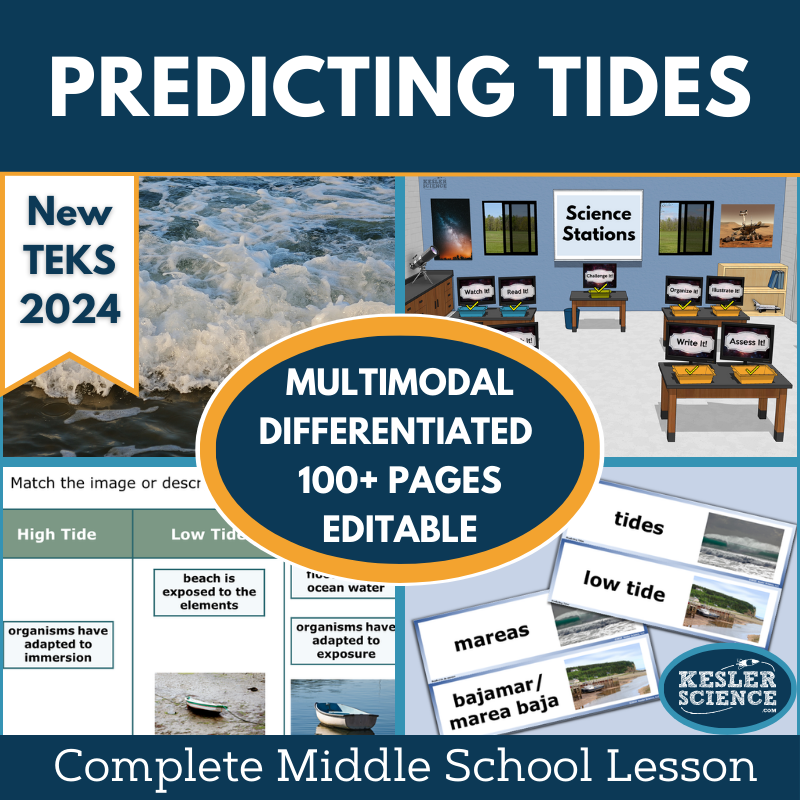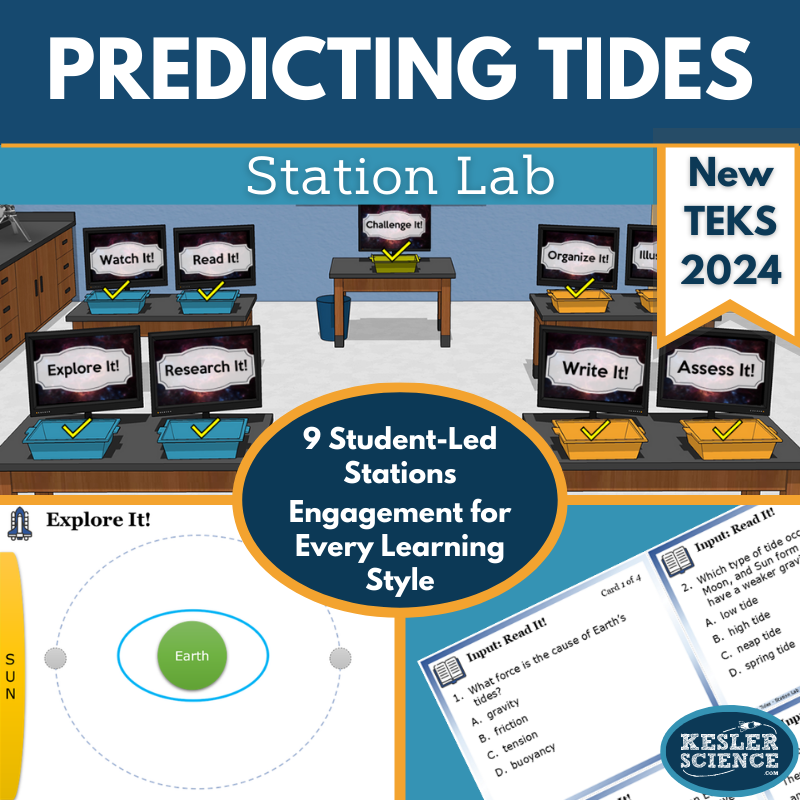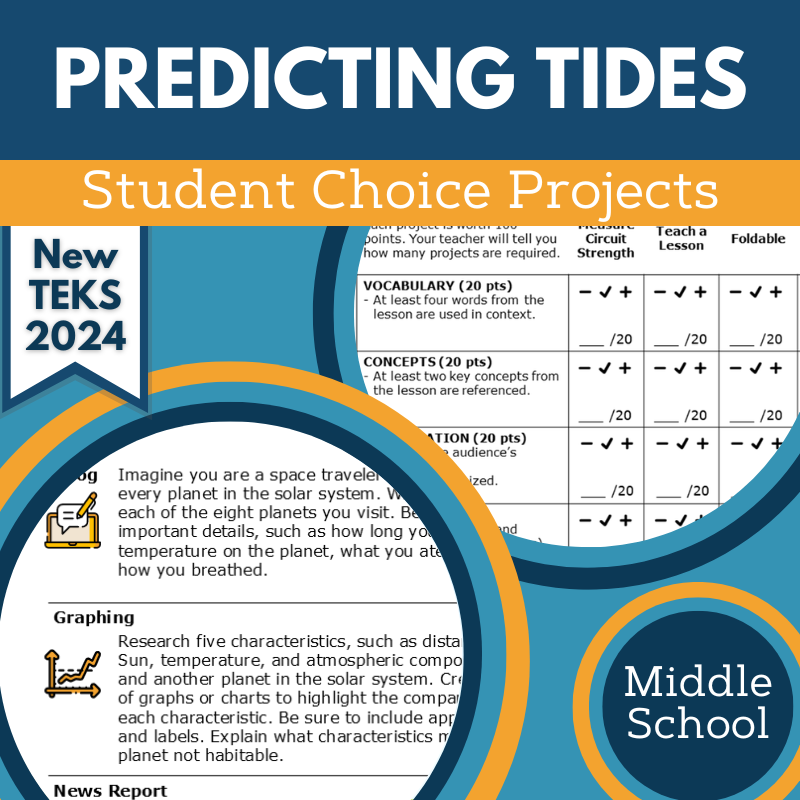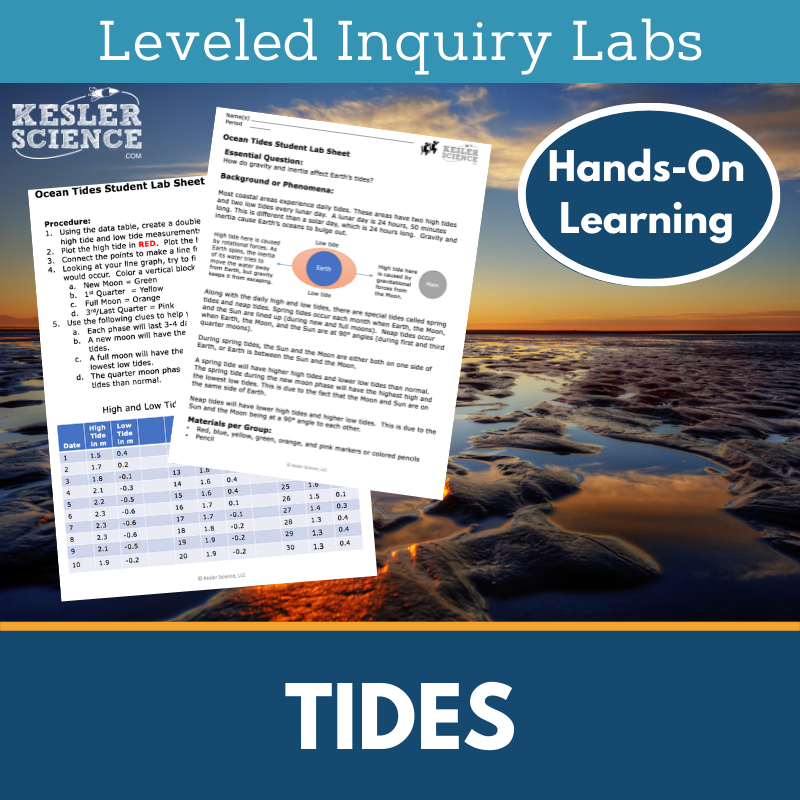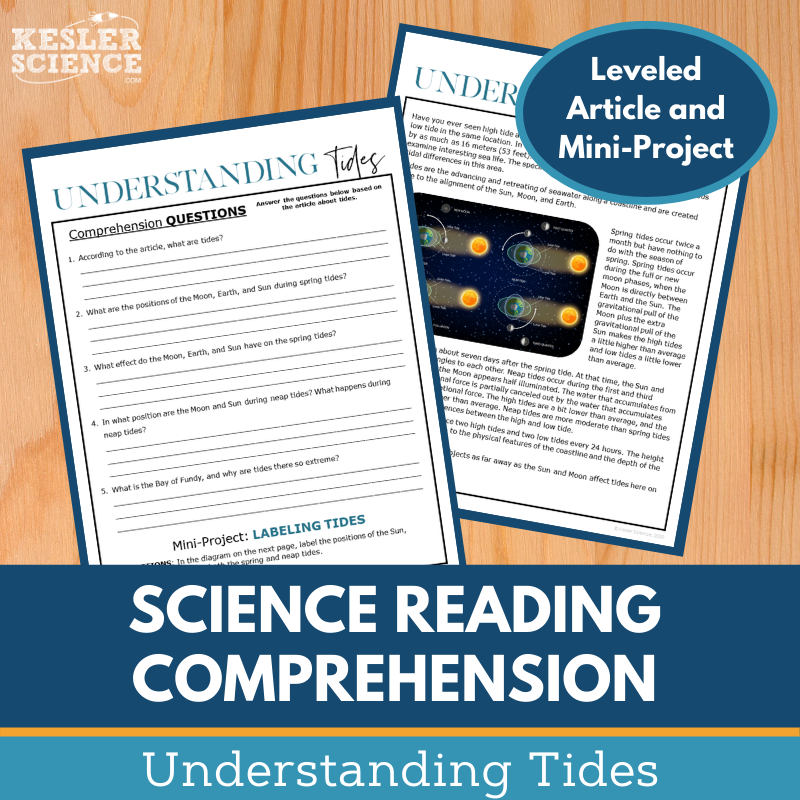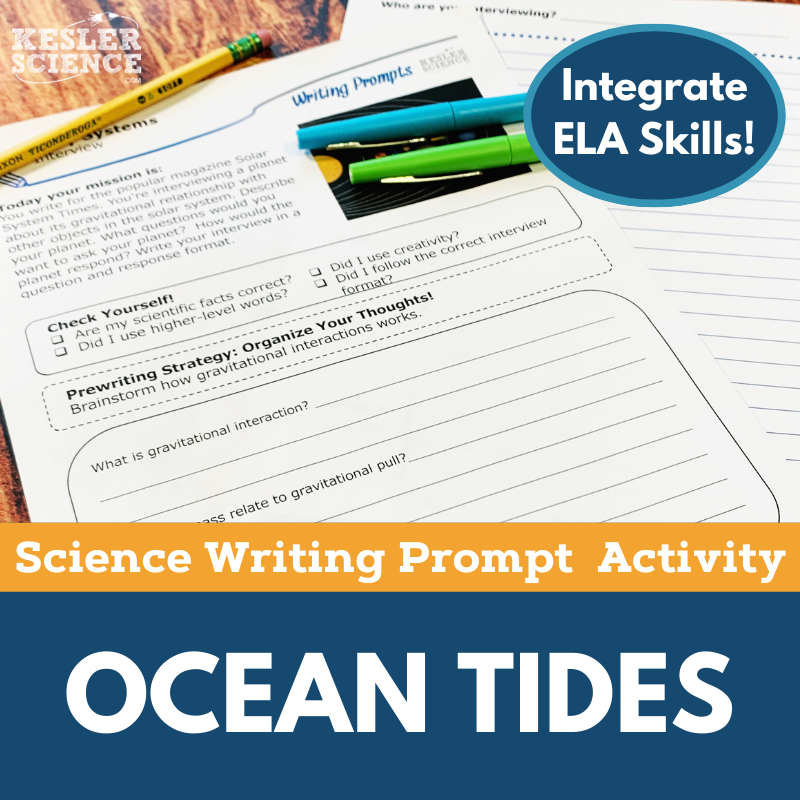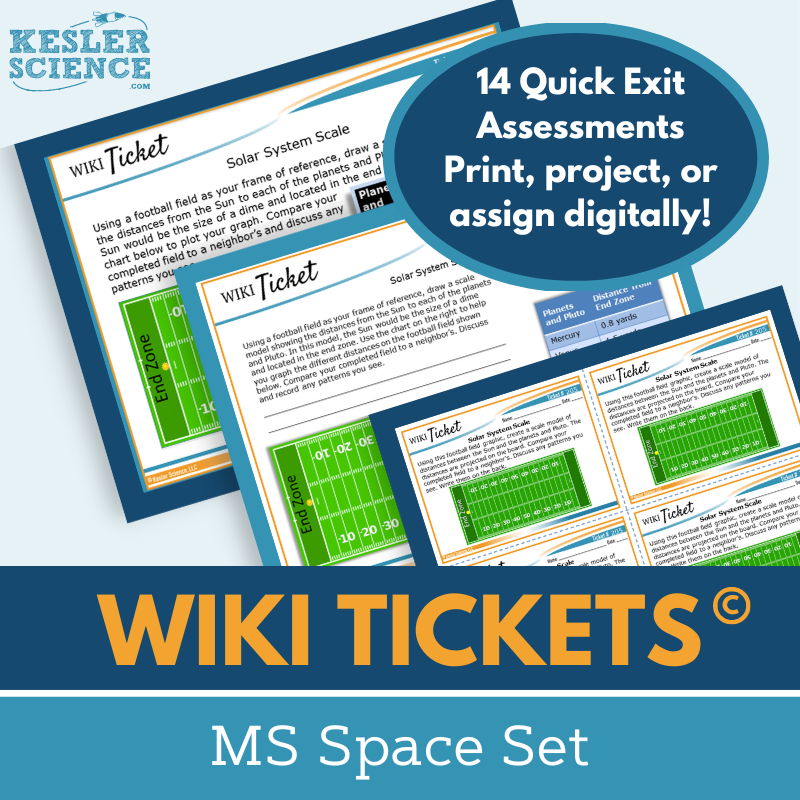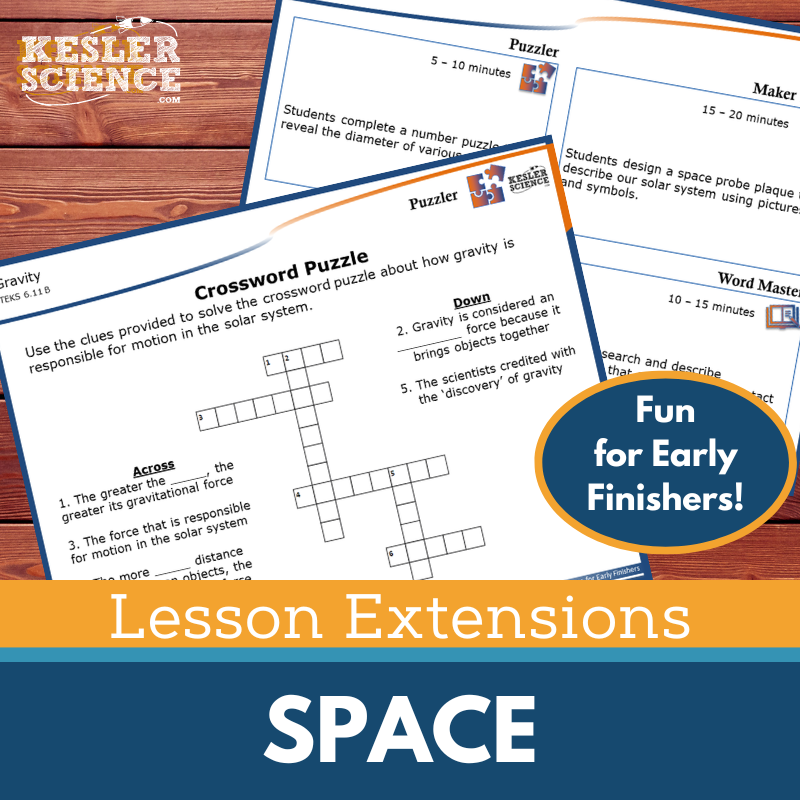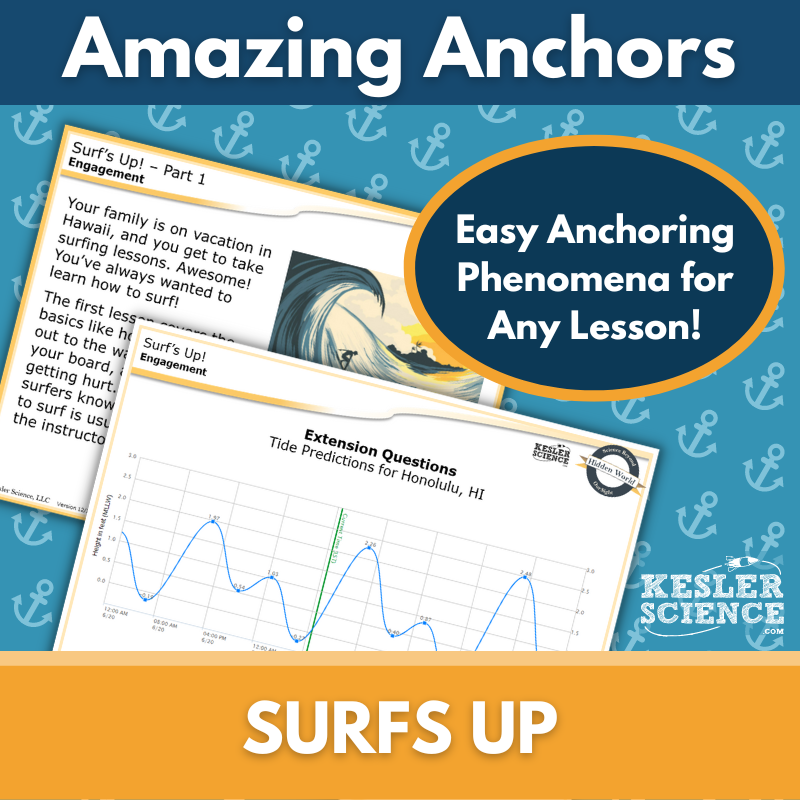Predicting Tides Activities for Middle School Science
This middle school space science unit helps students understand how the positions of Earth, the Sun, and the Moon cause ocean tides. The resources below will give students a comprehensive understanding of ocean tides. All of the following materials are also included in the Kesler Science Membership.
This middle school space science unit helps students describe and predict how the positions of Earth, the Sun, and the Moon cause ocean tides. It includes editable PowerPoints, worksheets, choice projects, and assessments, all aligned to the 2021 TEKS 6.9B standard. The lesson follows the 5E Model, offering activities for Engagement, Exploration, Explanation, Elaboration, and Evaluation.
In the Exploration phase, students engage in a differentiated, student-led station lab with various input and output activities. These include reading, watching videos, researching, writing, and organizing concepts. There's also a bonus Challenge It! station for early finishers. The Explanation phase features editable PowerPoints, interactive notebooks, and note-taking templates, all available in English and Spanish.
For Elaboration, students complete choice projects to deepen their understanding, and the Evaluation phase provides assessment questions aligned to STAAR 2.0. This flexible unit is perfect for in-class or virtual learning and requires minimal prep.
This middle school space science unit helps students describe and predict how the positions of Earth, the Sun, and the Moon cause ocean tides. It includes editable PowerPoints, worksheets, choice projects, and assessments, all aligned to the 2021 TEKS 6.9B standard. The lesson follows the 5E Model, offering activities for Engagement, Exploration, Explanation, Elaboration, and Evaluation.
In the Exploration phase, students engage in a differentiated, student-led station lab with various input and output activities. These include reading, watching videos, researching, writing, and organizing concepts. There's also a bonus Challenge It! station for early finishers. The Explanation phase features editable PowerPoints, interactive notebooks, and note-taking templates, all available in English and Spanish.
For Elaboration, students complete choice projects to deepen their understanding, and the Evaluation phase provides assessment questions aligned to STAAR 2.0. This flexible unit is perfect for in-class or virtual learning and requires minimal prep.
This student-led activity on predicting tides aligns with TEKS 2021 standard 6.9B and engages middle school students in Earth science. Students will explore how the positions of Earth, the Sun, and the Moon affect daily, spring, and neap tidal cycles due to gravitational forces. This modular, low-prep lesson is ideal for both in-class and virtual settings, allowing students to take charge of their learning.
The lab features nine differentiated stations, each providing a unique way for students to learn and demonstrate their understanding. These stations include activities like watching videos, reading passages, and conducting research, all designed to build knowledge about tides. Students will also engage in hands-on activities, such as organizing information, illustrating concepts, and writing responses to questions. The lesson ends with an assessment to check their understanding, along with a bonus challenge station offering extension activities for advanced students. The stations require minimal materials, which can easily be found in most classrooms.
This lesson is ideal for creating a personalized and engaging learning experience with minimal teacher direction.
This student-led activity on predicting tides aligns with TEKS 2021 standard 6.9B and engages middle school students in Earth science. Students will explore how the positions of Earth, the Sun, and the Moon affect daily, spring, and neap tidal cycles due to gravitational forces. This modular, low-prep lesson is ideal for both in-class and virtual settings, allowing students to take charge of their learning.
The lab features nine differentiated stations, each providing a unique way for students to learn and demonstrate their understanding. These stations include activities like watching videos, reading passages, and conducting research, all designed to build knowledge about tides. Students will also engage in hands-on activities, such as organizing information, illustrating concepts, and writing responses to questions. The lesson ends with an assessment to check their understanding, along with a bonus challenge station offering extension activities for advanced students. The stations require minimal materials, which can easily be found in most classrooms.
This lesson is ideal for creating a personalized and engaging learning experience with minimal teacher direction.
The Predicting Tides Student Choice Projects align with the 2021 TEKS standard 6.9B, offering middle school students a variety of project options. Students can choose from six project ideas or create their own, with an editable grading rubric for assessments by teachers, peers, or themselves. These flexible projects support creative and personalized ways for students to demonstrate their understanding.
The resources include nine project options plus a “design your own” choice, a teacher directions page with support and suggestions, and editable rubric pages covering vocabulary, concepts, presentation, clarity, and accuracy. Differentiated versions of the project page cater to both students needing remediation and those who require more challenging tasks.
The projects use standard classroom supplies like paper, markers, and scissors, with many options also available for digital completion.
The Predicting Tides Student Choice Projects align with the 2021 TEKS standard 6.9B, offering middle school students a variety of project options. Students can choose from six project ideas or create their own, with an editable grading rubric for assessments by teachers, peers, or themselves. These flexible projects support creative and personalized ways for students to demonstrate their understanding.
The resources include nine project options plus a “design your own” choice, a teacher directions page with support and suggestions, and editable rubric pages covering vocabulary, concepts, presentation, clarity, and accuracy. Differentiated versions of the project page cater to both students needing remediation and those who require more challenging tasks.
The projects use standard classroom supplies like paper, markers, and scissors, with many options also available for digital completion.
This Inquiry Lab helps students use tide data from one lunar month to explore how moon phases correlate with spring and neap tides. The resource includes three differentiated labs to support all learners.
The product features teacher resource pages with prep time, standards, objectives, directions, materials, and additional resources. It also includes answer keys, Claim, Evidence, and Reasoning (CER) conclusion prompts, and three reflection questions per lab. All materials are editable.
The three differentiated labs are:
- Dependent Student Lab: A structured lab with guided inquiry questions, designed for on-level learners.
- Modified Student Lab: A more structured experience with simplified instructions and sentence stems, for students requiring modifications.
- Independent Student Lab: A student-driven lab, ideal for advanced learners, where students make most of the decisions and have minimal guidance.
Materials required include colored pencils or markers (red, blue, green, yellow, orange, pink) and a pencil.
This Inquiry Lab helps students use tide data from one lunar month to explore how moon phases correlate with spring and neap tides. The resource includes three differentiated labs to support all learners.
The product features teacher resource pages with prep time, standards, objectives, directions, materials, and additional resources. It also includes answer keys, Claim, Evidence, and Reasoning (CER) conclusion prompts, and three reflection questions per lab. All materials are editable.
The three differentiated labs are:
- Dependent Student Lab: A structured lab with guided inquiry questions, designed for on-level learners.
- Modified Student Lab: A more structured experience with simplified instructions and sentence stems, for students requiring modifications.
- Independent Student Lab: A student-driven lab, ideal for advanced learners, where students make most of the decisions and have minimal guidance.
Materials required include colored pencils or markers (red, blue, green, yellow, orange, pink) and a pencil.
In this lesson, students learn about tides by reading a nonfiction article that explains how the positions of the Moon and Sun affect ocean tides. They complete comprehension questions and label the positions of the Sun and Moon during different tides. This resource is designed to engage middle school students in science literacy and reading comprehension through an interesting article, questions, and a hands-on mini-project.
The passage is appropriate for grades 6–8, with Lexile levels between 1100–1300. It includes 5–7 comprehension questions, a mini-activity, and a Cornell notes template. The lesson also features colorful graphics, printable in grayscale, and is suitable for both in-class and virtual learning environments, such as Google Classroom or MS Teams. This resource works well for absent students, extra credit, science sub plans, and whole-class instruction, promoting classroom discussions and helping to build science reading comprehension and textual analysis skills.
In this lesson, students learn about tides by reading a nonfiction article that explains how the positions of the Moon and Sun affect ocean tides. They complete comprehension questions and label the positions of the Sun and Moon during different tides. This resource is designed to engage middle school students in science literacy and reading comprehension through an interesting article, questions, and a hands-on mini-project.
The passage is appropriate for grades 6–8, with Lexile levels between 1100–1300. It includes 5–7 comprehension questions, a mini-activity, and a Cornell notes template. The lesson also features colorful graphics, printable in grayscale, and is suitable for both in-class and virtual learning environments, such as Google Classroom or MS Teams. This resource works well for absent students, extra credit, science sub plans, and whole-class instruction, promoting classroom discussions and helping to build science reading comprehension and textual analysis skills.
The Ocean Tides Science Writing Prompt Activity helps middle school students test their knowledge of earth science by engaging them in a “month in the life” format. This creative, student-centered activity enhances science reasoning and exploration, making it suitable for both in-person and virtual learning. The writing prompt is aligned with TEKS 6.9B, which relates the positions of the Moon and Sun to their effect on ocean tides.
The resource includes teacher directions, answer guides, project ideas, rubrics, projection and print handouts, and a digital PowerPoint version for Google Slides. It’s perfect for cross-curricular activities, pre-test assessments, student choice projects, or enrichment for early finishers. The prompt works well for extra credit, make-up work, or differentiation exercises and can be used as a TELPAS sample.
These writing activities are designed to be displayed on bulletin boards or compiled into student anthologies. Please note, the prompts assume students have prior knowledge of the topic or access to research materials.
The Ocean Tides Science Writing Prompt Activity helps middle school students test their knowledge of earth science by engaging them in a “month in the life” format. This creative, student-centered activity enhances science reasoning and exploration, making it suitable for both in-person and virtual learning. The writing prompt is aligned with TEKS 6.9B, which relates the positions of the Moon and Sun to their effect on ocean tides.
The resource includes teacher directions, answer guides, project ideas, rubrics, projection and print handouts, and a digital PowerPoint version for Google Slides. It’s perfect for cross-curricular activities, pre-test assessments, student choice projects, or enrichment for early finishers. The prompt works well for extra credit, make-up work, or differentiation exercises and can be used as a TELPAS sample.
These writing activities are designed to be displayed on bulletin boards or compiled into student anthologies. Please note, the prompts assume students have prior knowledge of the topic or access to research materials.
These formative assessments for 6th-8th grade science offer flexible options to check students' understanding in a fun, engaging way. The Space Set includes 14 topics, each with five format options: a full-screen projection version, three handout sizes (full, split, and quarter-page), and an interactive digital version for PowerPoint or Google Slides.
Aligned with NGSS and TEKS standards, some topics feature multiple tickets, and each standard has at least one ticket. A table of contents file is included to show alignment.
These assessments are designed for both in-person and virtual learning environments, making them versatile for various teaching settings. Topics covered include day, night, and seasons; electromagnetic spectrum; lunar cycle; space exploration; the Sun; and more.
WIKI Tickets© are great for exit tickets, bellringers, or quick checks. They can be projected for students to write on paper, printed in handout form, or assigned digitally for remote learning.
These formative assessments for 6th-8th grade science offer flexible options to check students' understanding in a fun, engaging way. The Space Set includes 14 topics, each with five format options: a full-screen projection version, three handout sizes (full, split, and quarter-page), and an interactive digital version for PowerPoint or Google Slides.
Aligned with NGSS and TEKS standards, some topics feature multiple tickets, and each standard has at least one ticket. A table of contents file is included to show alignment.
These assessments are designed for both in-person and virtual learning environments, making them versatile for various teaching settings. Topics covered include day, night, and seasons; electromagnetic spectrum; lunar cycle; space exploration; the Sun; and more.
WIKI Tickets© are great for exit tickets, bellringers, or quick checks. They can be projected for students to write on paper, printed in handout form, or assigned digitally for remote learning.
Lesson Extensions offer engaging, student-choice activities designed to challenge fast finishers and deepen understanding of space science standards. These activities keep students engaged with critical thinking and creativity, making them ideal for lesson wrap-ups, testing downtime, or curbing distractions.
Each Lesson Extension includes four components: Puzzler for problem-solving, Maker Space for hands-on STEAM activities, Tech Connection for digital demonstrations, and Word Master for creative writing. Teacher directions, answer keys, and both projection and print versions are provided for ease of use.
These extensions are perfect for scaffolding learning and enriching students who are ready to explore topics like space science. The topics covered include components of the universe, Earth, the Moon, and the Sun, gravity, humans in space, lunar cycle, solar system objects, space travel, and more. The extensions are aligned to NGSS and TEKS science standards.
Lesson Extensions offer engaging, student-choice activities designed to challenge fast finishers and deepen understanding of space science standards. These activities keep students engaged with critical thinking and creativity, making them ideal for lesson wrap-ups, testing downtime, or curbing distractions.
Each Lesson Extension includes four components: Puzzler for problem-solving, Maker Space for hands-on STEAM activities, Tech Connection for digital demonstrations, and Word Master for creative writing. Teacher directions, answer keys, and both projection and print versions are provided for ease of use.
These extensions are perfect for scaffolding learning and enriching students who are ready to explore topics like space science. The topics covered include components of the universe, Earth, the Moon, and the Sun, gravity, humans in space, lunar cycle, solar system objects, space travel, and more. The extensions are aligned to NGSS and TEKS science standards.
This Amazing Anchors lesson introduces ocean tides through a two-part activity that includes an engaging reading on surfing in Hawaii followed by an explanatory reading on the science of tides, explaining how Earth, the Sun, and the Moon interact. Comprehension and extension questions help deepen student understanding.
The lesson includes teacher directions, answer keys, and additional resources, along with a projection version for easy display, a digital version for LMS sharing, and a paper version for handouts.
Aligned with TEKS, this lesson can be used in both print and digital formats, making it suitable for in-person or distance learning. Differentiated versions, with sentence starters and modified language, support students at different levels.
This lesson is designed to complement your own content, serving as a supplement to introduce or reinforce the concept of ocean tides.
This Amazing Anchors lesson introduces ocean tides through a two-part activity that includes an engaging reading on surfing in Hawaii followed by an explanatory reading on the science of tides, explaining how Earth, the Sun, and the Moon interact. Comprehension and extension questions help deepen student understanding.
The lesson includes teacher directions, answer keys, and additional resources, along with a projection version for easy display, a digital version for LMS sharing, and a paper version for handouts.
Aligned with TEKS, this lesson can be used in both print and digital formats, making it suitable for in-person or distance learning. Differentiated versions, with sentence starters and modified language, support students at different levels.
This lesson is designed to complement your own content, serving as a supplement to introduce or reinforce the concept of ocean tides.
Year-Round Resources
These year-round activities will increase your students' understanding of many middle school science topics. All of these activities are also included in the Kesler Science Membership.
Visual Data & Graphing
You're not alone if your students struggle with understanding graphs, charts, and tables. It's a skill that takes an enormous amount of practice. This resource will help students build a strong foundation in analyzing data and creating their own data visualizations.
Bell Ringers and Warm-Ups
These middle school science bell ringers are an excellent way to engage your students as soon as they walk into your classroom. This comprehensive FULL YEAR resource includes everything you need to start off each science class with an interesting warm-up activity.
Review Board Games
Each game board has been carefully designed to keep students engaged. There are 10 different action spaces on each board and dozens of question cards. All of the actions are related to science concepts and keep the students motivated throughout the game.
Each game is ready to play. Simply print out the board and the cards and let the students enjoy reviewing nine different units.
Essential Questions and Standards
Below are the essential questions and standards associated with the lessons and activities included in the atoms unit. This topic is only one of more than 100 middle school science topics included in the Kesler Science Membership.
-
How do we predict Earth’s daily tides by describing the positions of the Earth, Sun, and Moon?
-
What causes spring and neap tide cycles?
-
TEKS Science - 6.9B Predicting Tides
Kesler Science Membership
Imagine never having to search for another middle school science lesson again. The membership gives you access to ALL of the Kesler Science products in one place (Yes, including everything above).
Say goodbye to long hours of lesson prep.

